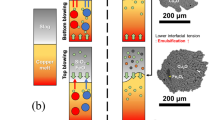Abstract
The rate of liquid copper oxidation plays an important role in the separation of impurities from copper during fire refining. However, the importance of factors affecting the rate of oxygen uptake by liquid copper is not clear. Top blowing oxidation of molten copper shows that the rate of oxidation is almost independent of the average oxygen concentration of the copper and proportional to the oxygen flow rate of the gas mixtures used. A pressure monitoring technique was used to determine the effect of a carrier gas such as N2, helium, and CO2, and the effect of the lance distance from the liquid surface on the partial pressure of oxygen in the gas phase. A numerical model was developed to help understand the mechanism of oxygen mass transfer into the molten copper.
Similar content being viewed by others
References
J. Gerlach and P. Herfort, “The Rate of Oxygen Uptake by Molten Copper,” Metall, 22 (11) (1968), pp. 1068–1090.
J. Gerlach, N. Schneider, and W. Wuth, “Oxygen Absorption during Blowing of Molten Cu,” Metall, 25 (11) (1972), pp. 1246–1251.
O. Frohne, G. Rottmann, and W. Wuth, “Processing Speeds in the Pyrometallurgical Refining of Cu by the Top-Blowing Process,” Metall, 27 (11) (1973), pp. 1112–1117.
R.G. Barton and J.K. Brimacombe, “Influence of Surface Tension-Driven Flow on the Kinetics of Oxygen Absorption in Molten Copper,” Metall. Trans. B., 8B (1977), pp. 417–427.
V.P. Zhukov, S.A. Mastyugin, and I.F. Khudyakov, “Absorption of Oxygen by Molten Copper During Top Blowing With Steam-Air Mixtures,” Sov. Non-Ferrous Met. Res., 14 (5) (1986), pp. 371–375.
A.A. Belousov, E.A. Pastukhov, and S.N. Aleshina, “Effect of Temperature, Partial Pressure of Oxygen on Kinetics of Oxidation of Liquid Copper,” Rasplavy, 2 (2003), pp. 3–6.
T. Marin et al., “Effect of Combustion Gases on the Rate of Liquid Copper Oxidation,” Copper 2003-Cobre 2003 International Conference, Vol. IV-Pyrometallurgy of Copper, Book 2: Technology Development, Process Modeling and Fundamentals, ed. C. Diaz, C. Landolt, and T. Utigard (Montreal, Canada: The Metallurgical Society of CIM, 2003), pp. 397–412.
V.G. Levich, Physicochemical Hydrodynamics, Prentice-Hall International Series in The Physical And Chemical Engineering Sciences, ed. N.R. Amundson, (Englewood Cliffs, NJ: Prentice-Hall Inc., 1962), pp. 384–386.
B. Gallois and C.H.P. Lupis, “Effect of Oxygen on the Surface Tension of Liquid Copper,” Metall. Trans. B, 12B (1981), pp. 549–557.
Author information
Authors and Affiliations
Additional information
For more information, contact T. Marin, University of Toronto, Department of Materials Science and Engineering, 184 College St., Toronto, Canada M5S 3E4; e-mail tanai.marin@utoronto.ca.
Rights and permissions
About this article
Cite this article
Marin, T., Utigard, T. & Marin, T. The kinetics and mechanism of molten copper oxidation by top blowing of oxygen. JOM 57, 58–62 (2005). https://doi.org/10.1007/s11837-005-0254-3
Issue Date:
DOI: https://doi.org/10.1007/s11837-005-0254-3




